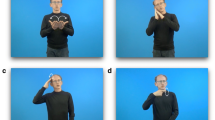Abstract
A comparative analysis of the time variables in the production of speech and sign reveals that signers modify their global physical rate primarily by altering the time they spend articulating, whereas speakers do so by changing the time they spend pausing. When signers increase or decrease their pause time, however little they do so, they alter the number and the length of the pauses equally, whereas speakers primarily alter the number of pauses and leave their pause durations relatively constant. An analysis of the durations of signs reveals that signs are longer at the end of sentences than within sentences and that the first occurrence of a sign is longer than the second when syntactic location is controlled (both these findings have already been reported for spoken language). The inherent duration of a sign can be accounted for almost totally by the movement characteristic; handshape, location, and number of hands in a sign are of little importance. Finally, signers retain their regular “quiet-breathing” respiratory pattern across signing rates and inhale at locations independent of syntactic importance. In this they are quite unlike speakers, who breathe at syntactic breaks.
Similar content being viewed by others
References
Battison, R. (1978).Lexical Borrowing in American Sign Language: Phonological and Morphological Restructuring, Linstok Press, Silver Spring, Md.
Bellugi, U., and Fischer, S. (1972). A comparison of sign language and spoken language.Cognition 1:173–200.
Bellugi, U., Klima, E. and Siple, P. (1975). Remembering in Signs.Cognition 3:93–123.
Covington, V. C. (1973). Juncture in American Sign Language.Sign Lang. Stud. 2:29–38.
Friedman, L. A. (1974). The manifestation of stress in the American Sign Language. Unpublished manuscript, University of California at Berkeley.
Frishberg, N. and Gough, B. (1973). Time on our hands. Unpublished manuscript, University of California at San Diego.
Grosjean, F. (1972). Le rôle joué par trois variables temporelles dans la compréhension orale de l'anglais étudié comme seconde langue et perception de la vitesse de lecture par des lecteurs et des auditeurs. Unpublished doctoral dissertation, University of Paris VII.
Grosjean, F. (1977). The perception of rate in spoken and sign languages.Perception and Psychophysics 22:408–413.
Grosjean, F., and Collins, M. (1979). Breathing, pausing and reading.Phonetica. 36:98–114.
Grosjean, F., and Deschamps, A. (1973). Analyse des variables temporelles du français spontané. II. Comparison du français oral dans la description avec l'anglais (description) et avec le français (interview radiophonique).Phonetica 28:191–226.
Grosjean, F., and Lane, H. (1977). Pauses and syntax in American Sign Language.Cognition 5:101–117.
Klatt, D. H. (1976). Linguistic uses of segmental duration in English: Acoustic and perceptual evidence.J. Acous. Soc. Am. 59:1208–1221.
Klima, E., and Bellugi, U. (1979).The Signs of Language. Harvard University Press, Cambridge, Mass.
Lane, H., and Grosjean, F. (1973). Perception of reading rate by speakers and listeners.J. Exp. Psychol. 97:141–147.
Lane, H., Boyes-Braem, P., and Bellugi, U. (1976). Preliminaries to a distinctive feature analysis of handshapes in American Sign Language.Cogn. Psychol. 8:263–289.
Martin, J. G. (1967). Hesitations in the speaker's production and the listener's reproduction of utterances.J. Verb. Learn. Verb. Behav. 6:903–909.
Miller, G. A. (1951).Language and Communication, McGraw-Hill, New York.
Poizner, H., and Lane, H. (1978). Discrimination of location in American Sign Language. In Siple, p. (ed.),Understanding Language Through Sign Language Research, Academic Press, New York.
Stokoe, W. C. (1960). Sign Language Structure: An outline of the visual communication system of the American deaf.Stud. Ling. Occasional Papers, No. 8.
Stokoe, W. C., Casterline, D. C., and Croneberg, C. G. (1965).A Dictionary of American Sign Language, Gallaudet College Press, Washington, D.C.
Supalla, T. (1976). Systems for modulating nouns and verbs in American Sign Language. Paper presented at the Conference on Sign Language and Neurolinguistics, Rochester, N.Y.
Umeda, N. (1975). Vowel duration in American English.J. Acous. Soc. Am. 58:433–445.
Author information
Authors and Affiliations
Additional information
This research was supported in part by Grant R03 MH 28133, Department of Health, Education, and Welfare.
Rights and permissions
About this article
Cite this article
Grosjean, F. A study of timing in a manual and a spoken language: American sign language and English. J Psycholinguist Res 8, 379–405 (1979). https://doi.org/10.1007/BF01067141
Received:
Issue Date:
DOI: https://doi.org/10.1007/BF01067141




